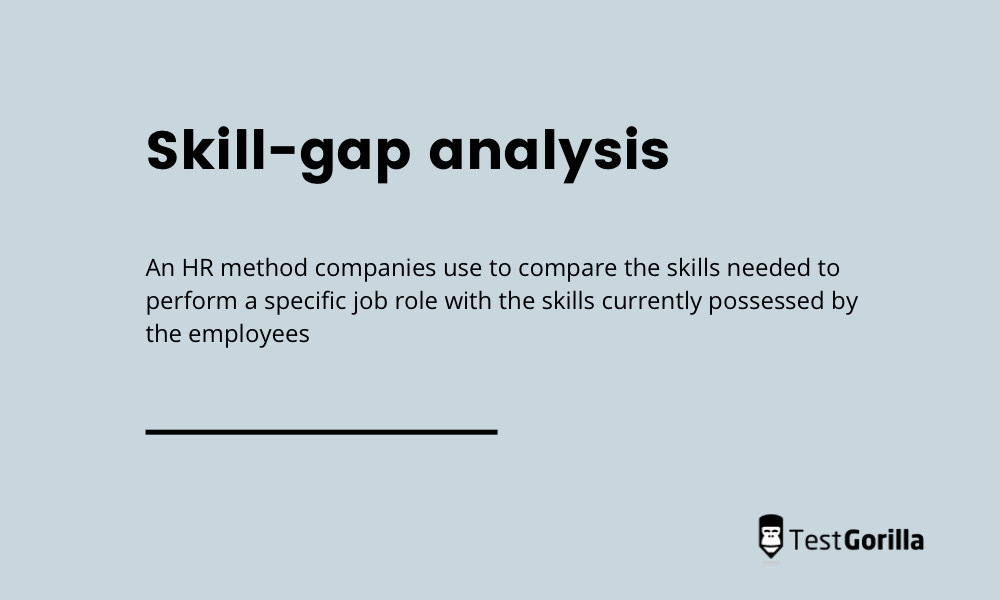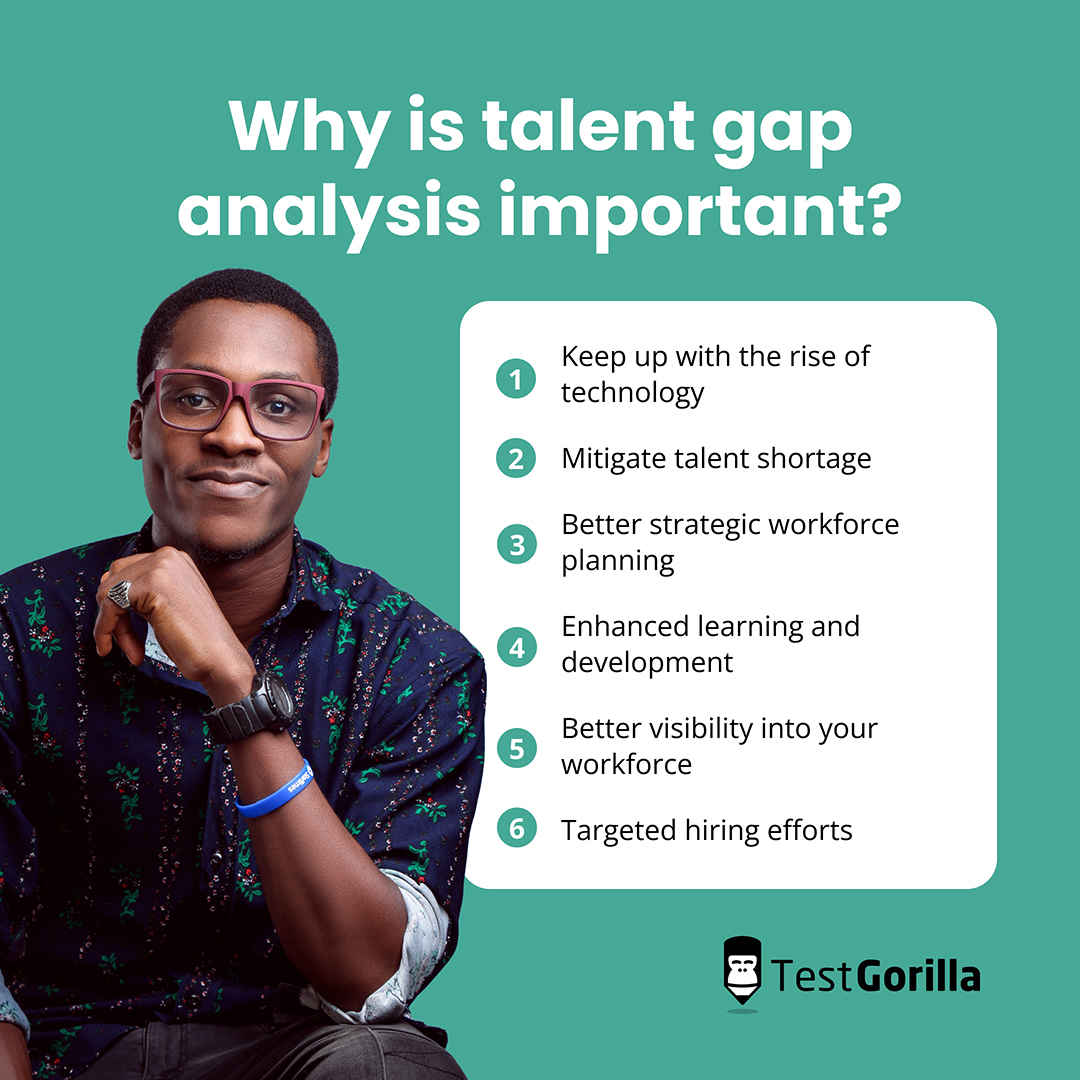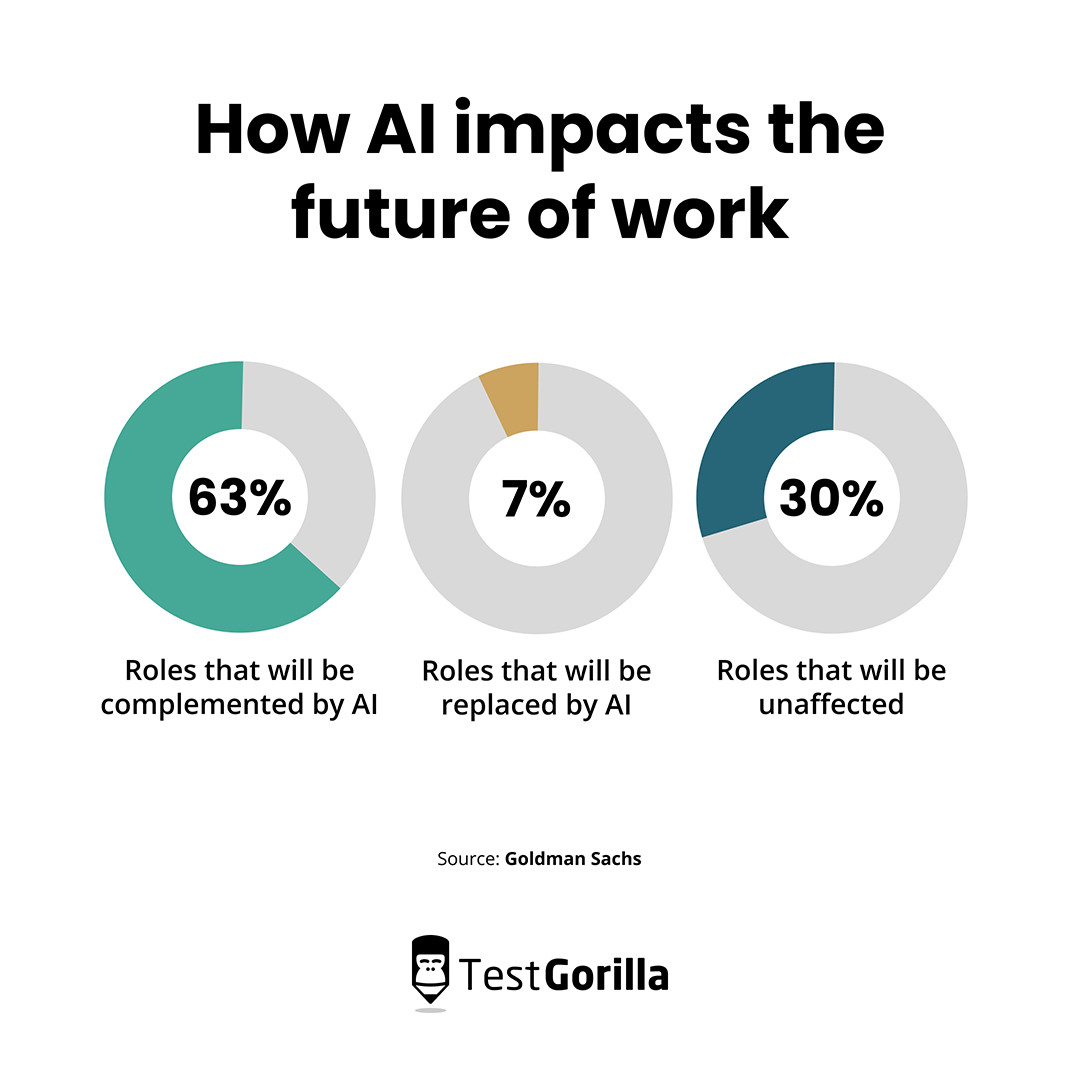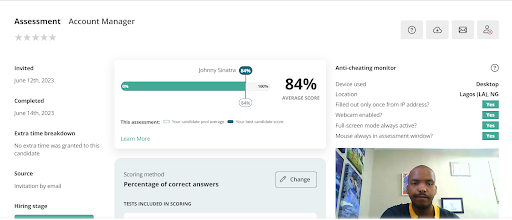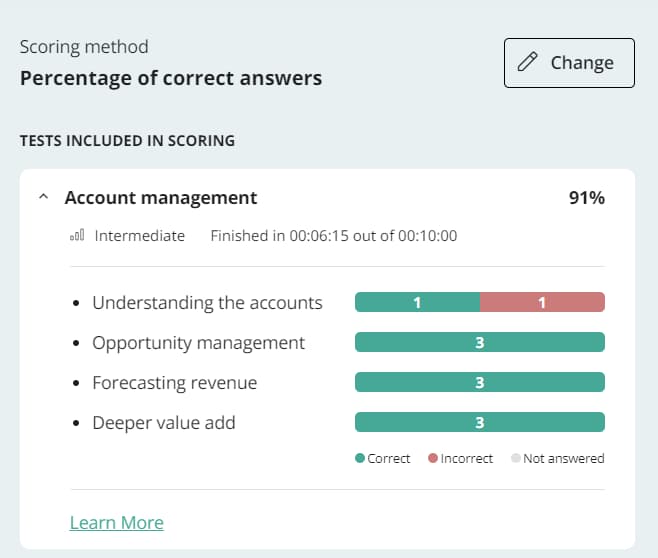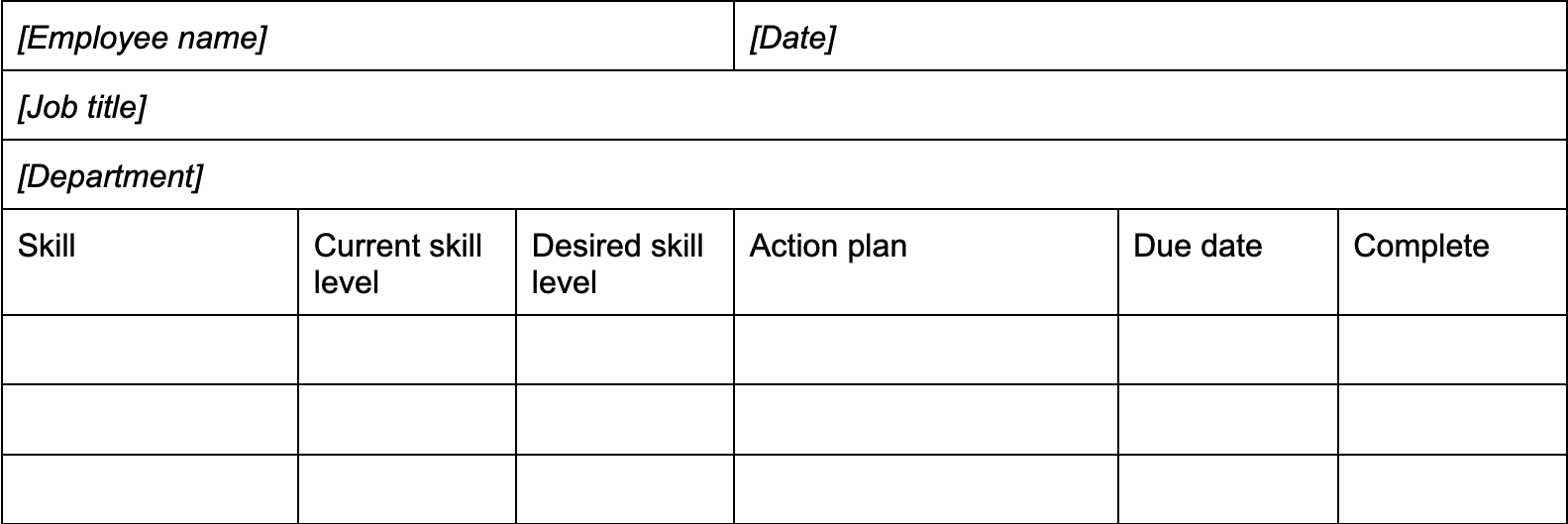A skills gap is the difference between the abilities your workforce has and the abilities your company needs to run properly. These gaps cause major issues, including reduced profits and wasted time and resources.
Talent gaps are incredibly common – 87% of organizations know they have skills gaps or expect to have them in the near future.[1]
For instance, let’s say your workforce needs more machine learning skills due to technological advancements. But this information isn’t exactly obvious, so how do you discover it?
A critical skills gap analysis helps you find these gaps so you can bridge them, maintaining efficiency and ensuring your organization stays competitive.
Conducting a skills gap analysis involves defining your goals, evaluating your workforce through questionnaires and talent assessments, and then building a plan to bridge your gaps.
This guide shows you how to execute a talent gap analysis step by step. It also provides examples and a useful template to use when conducting your own.
Table of contents
What is a skills gap analysis?
A skills gap analysis is the process of examining your workforce to find which skills it possesses and which specific skills it needs to succeed, and then analyzing this information to effectively bridge the gap. These gaps are frequently addressed via upskilling or reskilling staff, succession planning, and investing in learning and development initiatives.
This means skills gap analyses help inform both hiring and development efforts.
Talent gaps are common. They happen when there’s a disconnect between:
Required skills and available candidates who have them
Employers’ and candidates’ expectations
The urgency to fill roles and the efficiency and success of your hiring process
Advancing trends and your workforce’s skill sets
These gaps can sneak up on nearly every organization, especially because of an ongoing skills shortage and the rapid rise of technology.
Here are some signs that you need to do a skills gap analysis:
You’ve missed business objectives
You’re struggling to meet business objectives
You want to introduce new processes and technologies
These symptoms might mean that your current workforce is missing essential skills and competencies. However, you shouldn’t wait until the gaps become noticeable and problematic.
Ideally, you should conduct a talent gap analysis twice a year, or at least annually because you need regular skills gap analyses to stay on top of changing needs and industry trends.
Why is talent gap analysis important?
Bridging the talent gap is crucial for businesses to stay competitive, productive, and profitable.
Conducting a skills gap analysis gives you visibility into your workforce, keeps you current with changing environments, and helps target your hiring efforts.
Now, let’s deep dive into the top eight reasons why you should perform a skills-gap analysis at your organization.
1. Keep up with the rise of technology
Technology is changing at an unprecedented pace, and jobs are shifting because of it.
Artificial intelligence is entering organizations quickly. It isn’t “taking” as many jobs as people anticipated, but it’s changing the responsibilities of many roles.
One study found that 63% of jobs will be complemented by AI, 7% will be replaced, and only 30% will be unaffected.
Because few employees will be unaffected, companies need to discover these talent gaps, and then upskill and reskill their employees if they want to remain competitive.
Those who don’t adapt risk being displaced by companies that invested in their workforce.
Another way to prepare for the future of work is by hiring for potential.
This is the practice of finding employees who possess potential, such as adaptability and curiosity – which is key for building an agile workforce that’s ready for anything the future throws at them.
For more information on this topic, read our blog on how to stay ahead of the curve as the world changes.
2. Mitigate talent shortage
Hiring the right people isn’t easy – up to 77% of employers have difficulty filling open job roles.
A skills gap analysis shows you exactly what you need for your workforce, which is crucial during a skills shortage because:
You can devote your time to finding the necessary skills rather than putting time and effort into finding candidates who are potentially missing key abilities
You can upskill and reskill your current staff instead of hiring externally
Skills gap assessments enable you to bridge gaps efficiently, reducing the effort and costs of hiring when talent is in short supply.
Plus, finding hidden talent that’s already in your workforce is efficient and affordable. It encourages a culture of internal mobility, which increases employee retention.
3. Better strategic workforce planning
Conducting an employee skills gap analysis gives you an overview of your current skills, helping you anticipate and plan for future organizational needs.
Strategic workforce planning helps you understand your workforce’s capacity and enhance your succession planning efforts, leading to better business results.
For example, you might discover that your company lacks key graphic design skills but not enough to hire two in-house professionals. Your skills gap analysis might show that you could effectively bridge your gaps with one traditional employee and one contractor.
This plan is essential for your company’s future, helping you hire more effectively and leverage your current staff successfully.
4. Enhanced learning and development
Analyzing skills gaps enables you to target your development initiatives, aligning them to your business goals and helping employees learn relevant skills.
This not only helps your people develop more effectively, but it also enhances your career growth culture and empowers you to build better learning strategies.
Better learning and development strategies are essential as an employee retention strategy because they’re an expectation nowadays. They also help attract new talent.
One study found that 48% of workers would switch jobs if offered development opportunities, and 65% believe employer-provided upskilling is important when evaluating a possible job.
5. Better visibility into your workforce
Knowing what’s going on in your workforce helps you make better decisions, such as who to coach and which project needs new team members.
A talent gap analysis gives you heightened visibility into the skills and missing skills in your company. Further, if you execute your analysis with talent assessments, you can leverage data-driven insights about your workforce.
Talent assessments give you exact percentages rather than using subjective words like “proficient” or number rankings like “two” or “three.”
Ratings like this are decided by a human on the spot and can hold many different meanings, especially between different HR team members. One manager may consider an employee to possess a “three,” and another may consider their skills to be a “four.”
We cover this in more detail later.
6. Targeted hiring efforts
A talent gap analysis shows you specific data on the capabilities of your people – knowing which skills your employees possess and what they lack contributes to building your talent strategy.
This information helps external and internal hiring efforts.
A clear understanding of who can do what and in which position is the best way to build employee engagement. Our report found that 68% of employees prefer a skills-based hiring process.
The information you receive from the skills gap analysis also helps establish a plan for what individual employees need to do to improve their work, boost productivity, and move into new roles with minimal onboarding and ramp-up times.
7. Better competitive advantage
Learning how to perform a skills gap analysis helps you stay competitive in two major ways:
If your workforce is struggling to keep up with internal processes and fulfill business goals, your company will fall behind
If other companies are adapting to new technologies like AI and machine learning, but you aren’t, your company will fall behind
Conducting a skills gap analysis keeps your own processes running smoothly so you can maintain business as usual, but more than that, it also empowers you to teach trending skills to your staff so you can stay ahead of the curve.
8. Tailored learning and development
Every person has specific needs and areas of improvement, so across-the-board tactics don’t work.
A skills gap analysis enables you to concentrate your efforts on specific training courses for particular employees instead of training everyone in the same way.
Some employees may lack some soft skills while others may lack hard skills, and doing a skills gap analysis helps you determine exactly that.
Tailoring training programs to employees’ individual needs makes them more effective and productive, which benefits their everyday experience and your company’s performance.
Conducting a skills gap analysis in 6 steps
Learning how to perform a skills gap analysis is the first step to introducing them into your regular processes, so let’s dive into our simple guide.
Here are our six steps for conducting a talent gap assessment effectively and efficiently.
Step-by-step guide to a talent gap analysis: A summary
Step | What it accomplishes |
1. Determine short- and long-term business goals | Discovering your business objectives helps you find the exact skills necessary for current and future strategies |
2. Analyze skills and competencies | Evaluating your current employees, especially with talent assessments, helps you objectively discover the gaps in your workforce |
3. Decide how you intend to close the gaps | Using a variety of methods bridges talent gaps simply and affordably |
4. Execute your plan | Taking care to maintain hiring and training consistency through skills-based practices results in you recruiting and retaining high-performing employees |
5. Monitor and measure the results | Measuring the results of your talent gap analysis informs your future projects |
6. Commit to regular skills gap analyses | Dedicating your company to regular assessments maintains your workforce |
1. Determine short- and long-term business goals
A skills gap analysis helps you discover which skills and competencies are necessary for your company’s success, which means you need to determine what your business objectives are.
Talk with leaders to pinpoint strategies and organizational goals, both current and future. Leadership has the strongest idea of where the company is headed – do you want to increase sales or reduce costs, by, for example, increasing tech automation?
This helps you determine which skills you need so you can compare them with what you have.
Ask yourself these questions before planning with leadership:
What are the company’s goals for the next one, three, and five years?
Are there any specific tasks and projects on the horizon?
Do employees have the necessary skills to complete these projects?
In which areas does the company need to enhance its skills?
You can also discuss market trends with team leaders, such as which skills are currently on the rise or software that’s rapidly becoming essential in your industry.
With this information, you can understand where your organization is headed, which skills to prioritize, and which might not be as crucial in the short-term.
2. Analyze skills and competencies
It’s time to analyze your workforce’s talent gaps. First, you need to decide if you’re doing your assessment on an individual or team level.
Individual level: A talent gap on an individual level means an employee doesn’t have the right skills to perform every part of their job independently
Team level: At a team or company level, a talent gap means the team or organization as a whole doesn’t have the right skills to compete in the market
You can also conduct individual assessments and then a team-wide one, depending on your needs.
Next, you must choose the methods to use to evaluate the skills themselves. There are a variety of ways to conduct a talent gap assessment:
Method | Description |
Talent assessments | Tests that accurately identify skills and personality traits in an easy-to-understand way |
360-degree evaluation | Asking for performance feedback from an employee’s colleagues, managers, and even customers |
SWOT analysis | A self-assessment to discover an employee’s strengths, weaknesses, opportunities, and threats |
External evaluation | Hiring a professional to assess your company’s and employee’s skills |
These are all valid methods, but talent assessments provide the deepest insights, cost less, and give you the most accurate results.
Other methods, although somewhat effective, have drawbacks, such as a 360-degree evaluation having a risk of bias or an external evaluation costing quite a hefty sum.
3. Decide how you intend to close the gaps
After the evaluation, you know what your company needs and just need to bridge the gaps.
The top ways of bridging the talent gap are:
Hiring
Upskilling
Reskilling
Mentorship
Outsourcing
Mentoring, upskilling, and reskilling are three of the most important strategies. They enable you to close gaps quickly and affordably, while satisfying employee wants for internal mobility.
They’re also the most common way to address skills gaps, with 65% of organizations using them.
Encouraging learning, training, and knowledge-sharing are critical strategies for the health of your business.
One study found that 84% of companies agree that continual reinvention of the workforce through lifelong learning is important to their development strategies, yet only 16% expect their organization to make a significant investment in this area in the coming years.
Further, 32% identified lack of investment as the greatest barrier to workforce development.
A quick way to connect employees to real-life upskilling opportunities is via quick projects and gigs in an internal talent marketplace. This gives employees real scenarios to build up their areas of improvement and to nurture new skills.
Another effective way to fill skills gaps is by bridging them with adjacent skills. For example, you can fill a need for social media marketing by securing a candidate with content marketing skills and building up their LinkedIn marketing skills with training sessions or professional certifications.
4. Execute your plan
You’ve built your plan – perhaps you’re upskilling for the majority of your necessary skills and hiring for a few. Here are some tips for carrying out your strategy.
For hiring, we recommend you recruit new hires with talent assessments to maintain consistency between the analysis and hiring. This way, the same tests that showed you the talent gap can show you whether the candidate has what it takes to excel.
For instance, you could test for generative AI skills, find your team’s digital talent gap, include the needed skills in your job description, and use the same assessment to help you recruit a candidate with the right skills to fill the gap.
It’s also important to execute your upskilling and reskilling strategy the right way.
Ensure you evaluate employees and find out how they learn best to maximize efficiency. Ask them during one-on-ones or assess their learning style and agility with tests.
Don’t forget to help them build a professional development plan to keep track of their goals, resources, and strategies. It’s also crucial to monitor their progress – let’s get to that next.
5. Monitor and measure the results
A skills gap analysis is only as good as the results it brings, so be sure to monitor and measure the effectiveness of your hiring and development plans.
This is important for obvious reasons, such as improving your performance and return on investment, but it also helps inform future skills gap assessments.
For example, you can conduct a small, team-level skills gap analysis to test the waters. Afterward, if it’s successful, you can expand your efforts and do it department-wide next time.
There are a variety of methods for tracking progress and measuring success:
Key performance indicators (KPIs) is a data-backed method to track company goals and employee performance via pre-determined metrics
Talent assessments issued regularly to develop employees enables you to monitor their growth accurately (at individual and team levels)
Performance reviews provide qualitative insight from peers and managers about an employee’s productivity and engagement
Once you have your results, share them with all stakeholders to keep them in the loop and win further support for your project. This approach helps skills gap analyses gain a foothold in your company culture.
6. Commit to regular skills gap analyses
Conducting skills gap analyses is part of a good company culture. This strategy should be ongoing – not a one-and-done thing.
Ideally, you should perform a talent gap analysis twice a year, but it should be done at least once a year to account for new employees and changing markets.
Regular talent gap analyses enable you to:
Learn more about your business and tailor your training efforts to your needs
Make better use of your learning and development resources
Keep reinforcing your skills with the latest practices to stay ahead of the competition
Improve your talent strategies to minimize talent gaps and make better hires
A skills gap analysis is about maintaining your workforce. The effort you put into managing and optimizing your talent helps prevent expensive damage later.
Skills gap analysis examples
Now let’s take a look at two skills gap analysis examples.
We’ll review a typical talent gap analysis on a spreadsheet and then take a look at one conducted with talent assessments.
This not only gives you a solid understanding of skills gap analyses; it also helps you build your own standardized process.
Typical skills gap analysis
A standard skills gap analysis on spreadsheets is straightforward. Generally, you gather employee data and then lay it out in different columns, comparing current skills levels to desired skills levels.
Here’s a sample employee skills gap analysis for a sales development representative:
Skill | Current skill level | Desired skill level |
CRM Proficiency | 3 | 4 |
Negotiation | 2 | 4 |
Product and service knowledge | 4 | 5 |
You can further organize this type of analysis by creating different spreadsheets for different uses, such as sorting them by soft skills or by team.
The problem with this method is inconsistency. Using subjective number rankings makes it difficult to ascertain accurate skill levels.
One manager handling this analysis may score workers differently because of their perception of how skills present – for example, an extroverted employee may be a “three,” while an introverted coworker is rated a “two” despite having the same skill proficiency.
But it gets even more inconsistent when you have multiple people conducting the analysis, which is likely. Multiple people analyzing different employees can’t help but rate them inconsistently since each person has a slightly different idea for a scoring system.
Talent assessment skills gap analysis
It’s time to run through a skills gap analysis using talent assessment tests.
This method is much more accurate, objective, and fast – and using talent assessments ensures accuracy and consistency for every employee.
Plus, it’s easy for multiple human resources professionals to conduct the skills analysis together because scoring won’t be subjective, and they all have easy access to the central database. Here’s how TestGorilla’s talent assessment method works:
After the employee finishes the assessment, you receive deep insights into their skills and competencies. This enables you to review each person in-depth, examining their overall average score.
However, you can also go deeper into each test to zero in on their areas of improvement.
Here you can see that this person scored perfectly in three categories out of four, but they could use more training in “understanding the accounts.”
This facilitates laser-focused learning and development programs.
For example, a general account management course may not provide the above employee with the opportunities they need. But with specific information, you can ensure they receive the exact lessons that help bridge their gaps.
You can then carry on using talent assessments as you execute your plan.
Unlike spreadsheets, talent assessments can be used to monitor your employee’s growth and the success of your skills gap analysis as a whole.
This not only helps you plan for the future projects – it also enables you to more easily secure future leadership buy-in thanks to your data-based approach.
With data-driven recruiting methods like talent assessments, you can present easy-to-understand, straightforward numbers, such as a clear raise from 60% to 80%.
Talent gap analysis template and checklist
Here’s our blank skills gap analysis template, so you can get started right away.
It’s a simple, spreadsheet-style template that doubles as a checklist because it has a column to check off each gap as you bridge it.
Start by filling in the employee’s name, job title, department, and the date you conducted the analysis.
Then fill out their skills and the intended action plan on how to address the gaps.
There’s also a section for the due date for each skill. Some skills may be more pressing and require a faster due date, such as one month, but others are more relaxed and may be due in three to five months.
You can use this template the standard way, measuring skills by numbered levels, but you can use this spreadsheet in conjunction with talent assessments, too.
Simply put employee test score percentages in the “skill level” column instead of number rankings.
Tip: If you’re conducting a skills gap analysis at a team or company level, make a version for each of your employees. Then, collate all the results in a central spreadsheet to give you an overview of current skill levels vs. desired skill levels.
If you use automated formulas, the overall scores change based on changes at the individual level, making it easy to track company performance.
We encourage all HR professionals to keep this template in your toolkit, bookmarking this page as a resource to use whenever you need it.
Level up your skills gap analysis with talent assessments
A skills gap analysis is not only a useful strategy to maintain your workforce – it’s essential for a healthy company.
Analyze your organization’s skills regularly to keep up with trends, inform hiring efforts, and target development initiatives.
To make the process quicker, easier, and more effective, leverage talent assessments to conduct your talent gap analysis. They give you data-driven insights and streamline the process.
For more details on this topic, read our blog on how talent assessments help you identify and bridge skills gaps.
If you’d like to learn more about talent assessments, browse our test library to familiarize yourself with a variety of skills tests.
Source
“The skillful corporation”. (January 8, 2021). McKinsey & Company. Retrieved December 4, 2023. https://www.mckinsey.com/capabilities/people-and-organizational-performance/our-insights/five-fifty-the-skillful-corporation
Related posts
Hire the best candidates with TestGorilla
Create pre-employment assessments in minutes to screen candidates, save time, and hire the best talent.
Latest posts
The best advice in pre-employment testing, in your inbox.
No spam. Unsubscribe at any time.

Hire the best. No bias. No stress.
Our screening tests identify the best candidates and make your hiring decisions faster, easier, and bias-free.
Free resources
This checklist covers key features you should look for when choosing a skills testing platform
This resource will help you develop an onboarding checklist for new hires.
How to assess your candidates' attention to detail.
Learn how to get human resources certified through HRCI or SHRM.
Learn how you can improve the level of talent at your company.
Learn how CapitalT reduced hiring bias with online skills assessments.
Learn how to make the resume process more efficient and more effective.
Improve your hiring strategy with these 7 critical recruitment metrics.
Learn how Sukhi decreased time spent reviewing resumes by 83%!
Hire more efficiently with these hacks that 99% of recruiters aren't using.
Make a business case for diversity and inclusion initiatives with this data.

